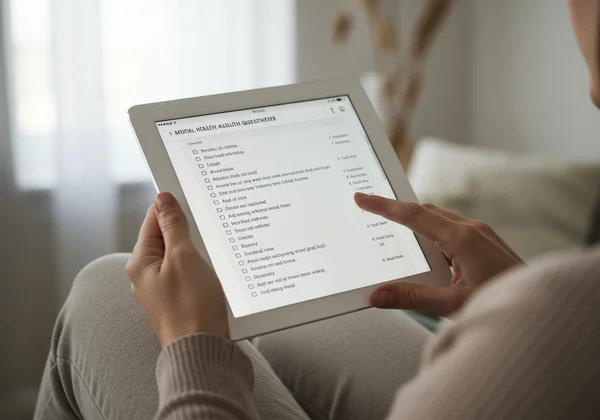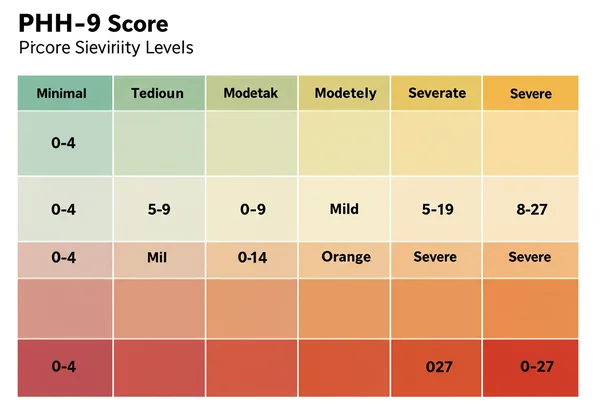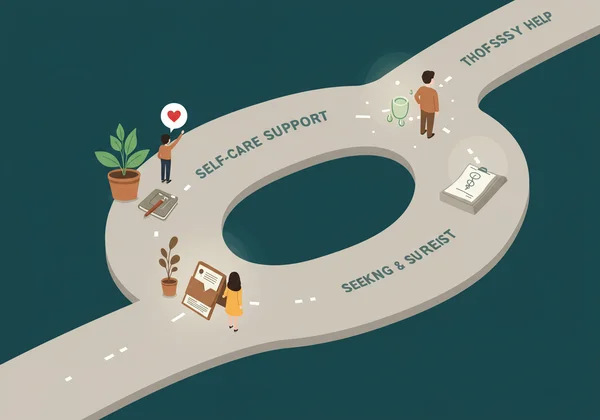PHQ-9 Score: Your Next Steps to Well-being
July 27, 2025 | By Clara Holloway
Taking a moment for an emotional check-up is a significant first step, and your PHQ-9 score offers a clear picture of your current emotional state. But you might be left wondering, what does my PHQ-9 score mean? Feeling unsure or even a little anxious after seeing your results is completely normal. This guide is here to walk you through understanding your score, offering clear, compassionate, and actionable guidance for your path toward well-being. This number is not a label; it's a starting point for a conversation.
The Patient Health Questionnaire-9 (PHQ-9) is a trusted tool used by professionals worldwide to screen for signs of depression. It helps quantify feelings that can often seem overwhelming and vague. If you haven't taken the test yet, you can take our free assessment on our homepage to get your confidential results in minutes. This guide will help you make sense of those results and decide what to do next.

Understanding Your PHQ-9 Score: What the Numbers Mean
Your PHQ-9 score is calculated from your answers to nine questions about your experiences over the last two weeks. Each response is assigned points, which are then totaled to give you a score. Let's break down how this works and what the different levels indicate.
The PHQ-9 Scoring System Explained (0-27)
The PHQ-9 is designed to be simple and effective. For each of the nine questions, your answer corresponds to a point value:
- "Not at all" = 0 points
- "Several days" = 1 point
- "More than half the days" = 2 points
- "Nearly every day" = 3 points
These points are added up to produce a final score between 0 and 27. The higher the score, the more frequent and severe the symptoms of depression may be. Grasping this straightforward PHQ-9 scoring method clarifies the process, giving you the knowledge to take informed action.
Interpreting Your PHQ-9 Severity Levels
Once you have your total, it falls into a specific severity range. This PHQ-9 score interpretation is a standardized guide used to understand the potential level of depressive symptoms. Remember, this is a screening tool, not a diagnosis.
-
0-4 (Minimal Depression): Your score suggests you are likely experiencing few, if any, symptoms of depression. This is a great sign of positive mental well-being.
-
5-9 (Mild Depression): This range indicates the presence of mild depressive symptoms. While not severely impacting your daily life, these feelings are valid and worth paying attention to.
-
10-14 (Moderate Depression): A score in this range suggests that symptoms are more persistent and may be interfering with your daily activities, work, or relationships.
-
15-19 (Moderately Severe Depression): This indicates that depressive symptoms are significant and are likely causing considerable challenges in your day-to-day life.
-
20-27 (Severe Depression): Scores in this category suggest that symptoms are frequent, intense, and are very likely causing substantial impairment in your life.

Your Next Steps: Actionable Guidance Based on Your Score
Regardless of your score, there are always proactive steps you can take to support your mental health. The key is to match your actions to what your score suggests.
Minimal or No Depression (0-4): Maintaining Your Mental Well-being
A low score is wonderful news! This is the perfect time to focus on proactive and preventative care. Consider this an opportunity to reinforce healthy habits. Continue to prioritize good sleep, regular physical activity, a balanced diet, and strong social connections. Engaging in mindfulness or hobbies you love can also bolster your resilience for the future.
Mild Depression (5-9): Exploring Self-Care and Lifestyle Adjustments
If your score falls in the mild range, think of it as an early warning light. Now is an excellent time to explore self-care and lifestyle adjustments. You could start a journal to track your moods, try simple mindfulness exercises, or make a conscious effort to schedule enjoyable activities. Monitoring your symptoms is also wise; you could take the PHQ-9 again in a few weeks to see if there have been any changes.
Moderate Depression (10-14): When to Consider Seeking Support
With a moderate score, symptoms are likely becoming more difficult to manage on your own. This is a crucial point where it is wise to consider seeking support. Sharing your PHQ-9 results with a trusted friend or family member can be a good first step. More importantly, this is an ideal time to schedule an appointment with your primary care physician or a mental health professional to discuss your concerns.
Moderately Severe to Severe Depression (15-27): Prioritizing Immediate Professional Help
Receiving a high PHQ-9 score can be frightening, but it is a clear signal that you should not have to carry this burden alone. It is essential to be prioritizing immediate professional help. Your feelings are significant, and effective treatments are available. Please make an appointment with a doctor or mental health therapist as soon as possible to discuss your results and create a treatment plan. Your well-being is the top priority.

Beyond the Score: When and How to Seek Professional Support
Your PHQ-9 score is a powerful piece of information, but it doesn't tell the whole story. It's a starting point for a deeper conversation about your health.
Recognizing Other Signs: Beyond Your PHQ-9 Results
Listen to your gut. If you feel that something is wrong, even with a low score, it is always worth exploring. The PHQ-9 screens for common symptoms, but your unique experience matters most. Persistent feelings of hopelessness, changes in appetite or sleep, or loss of interest in life are all important signs to discuss with a professional.
Finding the Right Mental Health Professional for You
The thought of finding the right mental health professional can be daunting, but it's a manageable process. You can start by asking your family doctor for a referral. You can also check with your insurance provider for a list of covered therapists or counselors. Look for professionals who specialize in areas that concern you. Remember, finding the right fit is key to a successful therapeutic relationship.
Preparing for Your First Consultation
To make the most of your first appointment, do a little preparation. Write down your main concerns and any questions you have. It can be incredibly helpful to bring a printout or a screenshot of your PHQ-9 results. This gives the professional concrete, standardized information to begin the conversation, making it easier for you to explain what you've been experiencing. It's a great way to begin your journey toward feeling better.

Unlocking Deeper Insights: Your PHQ-9 AI Personalized Report
While the standard PHQ-9 score provides a severity level, you may want a more nuanced understanding of your situation. This is where our unique, optional feature comes in. We offer a personalized AI report that goes beyond the numbers.
How Personalized Analysis Can Guide Your Journey
By answering a few additional, voluntary questions, our AI can generate a personalized analysis of your results. This report can highlight your personal strengths, identify specific challenges, explain how your symptoms may be impacting daily life, and provide actionable, tailored suggestions. This deeper insight can be a crucial resource as you decide on your next steps and communicate with healthcare providers.
Your Journey to Well-being Starts Now
Receiving your PHQ-9 score is an act of courage and self-awareness. It's a tool that provides clarity and direction, not a final judgment. Whether your score prompts you to maintain healthy habits, explore self-care, or seek professional support, you have taken a vital step. You have empowered yourself with knowledge, and that is where every journey to well-being begins.
We encourage you to use this information as a guide. Start your assessment today if you haven't already, or revisit your results with this new understanding.
Frequently Asked Questions About Your PHQ-9 Score
What does my PHQ-9 score mean?
Your score represents a snapshot of the frequency and severity of potential depressive symptoms over the past two weeks. It is categorized into levels from minimal to severe to help you and healthcare providers understand the potential impact on your life. It is a screening tool, not a diagnostic one.
Can the PHQ-9 diagnose depression?
No, the PHQ-9 cannot diagnose depression. It is a highly reliable screening tool that identifies individuals who may benefit from further evaluation. A formal diagnosis can only be made by a qualified healthcare professional after a comprehensive assessment.
How often should I take the PHQ-9?
This depends on your situation. If you are starting a new treatment or making lifestyle changes, your doctor might suggest taking it every few weeks to monitor progress. If you are simply checking in on your mental health, taking it every few months or when you notice a change in your mood can be useful. Our free PHQ-9 assessment is always available for you.
What is considered a "positive" score on the PHQ-9?
A score of 10 or above is often used in clinical settings as a cutoff point indicating that a person may have clinically significant depression. However, any score above 4 suggests the presence of some symptoms, and any concerns should be discussed with a professional.
Is the PHQ-9 test reliable?
Yes, the PHQ-9 is a well-validated and reliable tool. It is widely used in clinical and research settings around the world to screen for depression and monitor symptom severity. Its reliability makes it a trustworthy first step in understanding your emotional health.